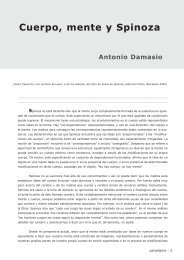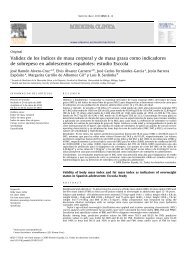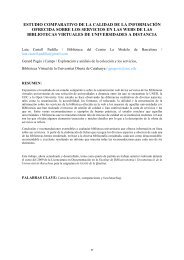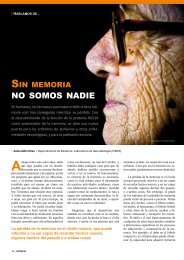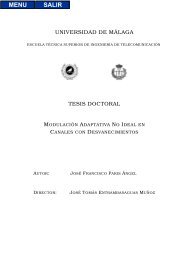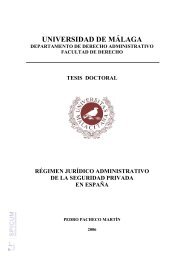Papel de las actividades superóxido dismutasa y catalasa en la ...
Papel de las actividades superóxido dismutasa y catalasa en la ...
Papel de las actividades superóxido dismutasa y catalasa en la ...
You also want an ePaper? Increase the reach of your titles
YUMPU automatically turns print PDFs into web optimized ePapers that Google loves.
RESULTS AND DISCUSSION<br />
The first objective of this PhD. Thesis consisted in the study of the contribution of<br />
superoxi<strong>de</strong> dismutase and cata<strong><strong>la</strong>s</strong>e activities to Photobacterium damse<strong>la</strong>e subsp.<br />
piscicida resistance against oxyg<strong>en</strong>ic radicals g<strong>en</strong>erated during respiratory burst in sole<br />
phagocytes and, therefore, their possible role as virul<strong>en</strong>ce factors (articles 1.1. and 1.2.,<br />
Article section).<br />
Previously, Barnes et al. (1999a) <strong>de</strong>monstrated in vitro that this microorganism<br />
contains <strong>en</strong>ough superoxi<strong>de</strong> dismutase activity to disproportionate photochemically<br />
g<strong>en</strong>erated superoxi<strong>de</strong> anions, and that the bacterial susceptibility is due to the action of<br />
hydrog<strong>en</strong> peroxi<strong>de</strong>. In fact, the addition of exog<strong>en</strong>ous cata<strong><strong>la</strong>s</strong>e to the medium protected<br />
the bacteria from inactivation by superoxi<strong>de</strong> anions. The role of cata<strong><strong>la</strong>s</strong>e and superoxi<strong>de</strong><br />
dismutase activities in P. damse<strong>la</strong>e subsp. piscicida virul<strong>en</strong>ce has be<strong>en</strong> studied in this<br />
work and results are inclu<strong>de</strong>d in articles 1.1. and 1.2. (Article section).<br />
In vitro role of cata<strong><strong>la</strong>s</strong>e activity in P. damse<strong>la</strong>e subsp. piscicida protection against<br />
exog<strong>en</strong>ous hydrog<strong>en</strong> peroxi<strong>de</strong> has be<strong>en</strong> evaluated in the first article. Results obtained<br />
show that resistance to hydrog<strong>en</strong> peroxi<strong>de</strong> increases wh<strong>en</strong> bacterial cultures are pulsed<br />
with hydrog<strong>en</strong> peroxi<strong>de</strong>. On the contrary, survival perc<strong>en</strong>tages <strong>de</strong>crease wh<strong>en</strong> bacteria<br />
grow un<strong>de</strong>r iron-limiting conditions. Quantification of cata<strong><strong>la</strong>s</strong>e activity in a set of P.<br />
damse<strong>la</strong>e subsp. piscicida strains shows that highest survival perc<strong>en</strong>tages are pres<strong>en</strong>t in<br />
bacterial cultures with higher cata<strong><strong>la</strong>s</strong>e activity levels. Moreover, resistance to oxidative<br />
stress varied <strong>de</strong>p<strong>en</strong>ding on the virul<strong>en</strong>ce, being higher in more virul<strong>en</strong>t strains. Thus, the<br />
virul<strong>en</strong>t strain Lg h41/01 shows higher resistance to respiratory burst of sole phagocytes<br />
than the non virul<strong>en</strong>t strain EPOY-8803-II, and hydrog<strong>en</strong> peroxi<strong>de</strong> addition into cultures<br />
increases survival. The <strong>la</strong>ck of cell capsule could contribute to the <strong>de</strong>crease of survival<br />
against reactive oxyg<strong>en</strong> species, but the low levels of cata<strong><strong>la</strong>s</strong>e activity obtained in<br />
EPOY-8803-II, suggest that its abs<strong>en</strong>ce of virul<strong>en</strong>ce could be <strong>de</strong>termined, in great part,<br />
by low cata<strong><strong>la</strong>s</strong>e activity. Therefore, cata<strong><strong>la</strong>s</strong>e p<strong>la</strong>ys an important role in P. damse<strong>la</strong>e<br />
subsp. piscicida virul<strong>en</strong>ce. It has be<strong>en</strong> <strong>de</strong>monstrated, in a great number of bacteria, that<br />
previous exposition to an oxidant in sublethal conc<strong>en</strong>trations can induce protection<br />
against lethal conc<strong>en</strong>trations of the oxidant (Mongkolsuk et al., 1996). Barnes et al.<br />
(1999b) reported that after being pulsed with hydrog<strong>en</strong> peroxi<strong>de</strong> A. salmonicida is able to<br />
97




